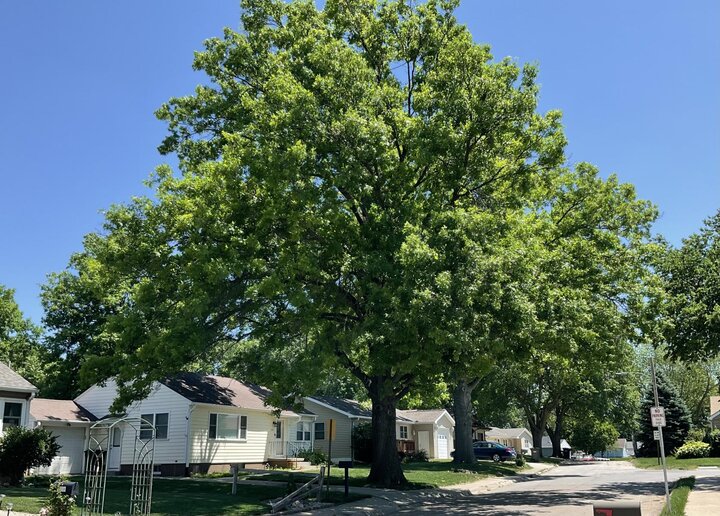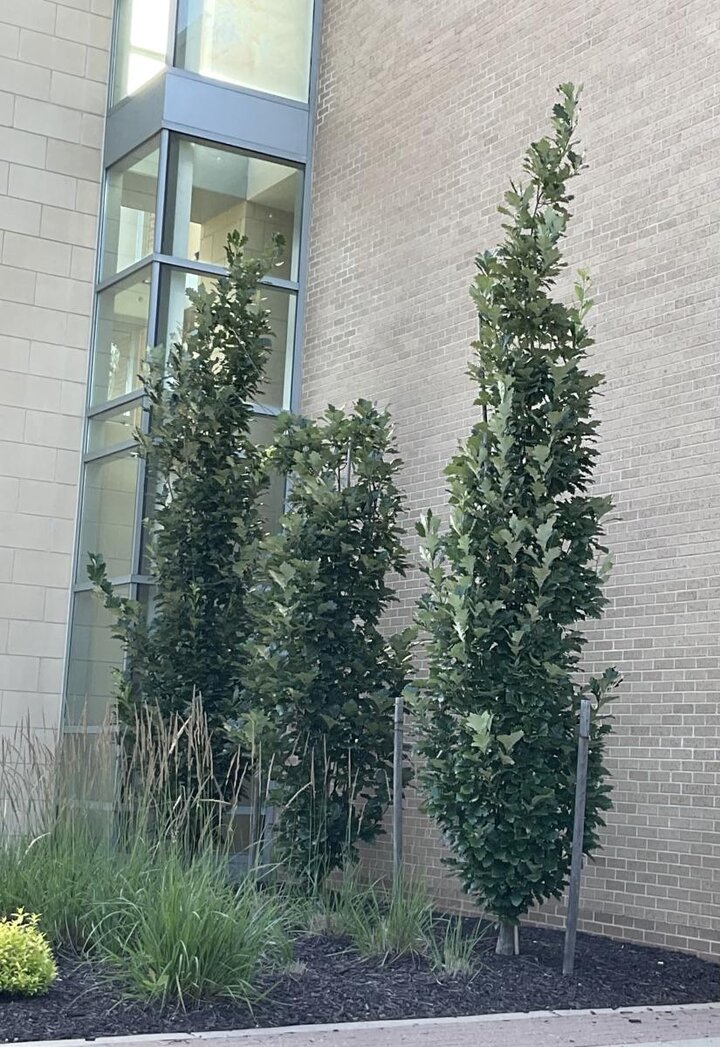Sarah Browning, Nebraska Extension Educator

Trees planted on the south or west side of a house usually provide the greatest amount of shade in summer. Image by Sarah Browning, Nebraska Extension Educator.
If you catch yourself saying, "I wish we had more shade around the house," now's the time to make plans. Shade trees provide the most benefits when planted on the south or west side of your house, but that doesn’t mean you may not also need shade in additional locations.

Assess the Site
Before even considering potential trees, take stock of the site’s growing conditions including soil, moisture and available sunlight. Plants grow much better and have fewer problems with insects and diseases when they're planted in sites that meet their specific needs. Finding out what conditions prevail in the proposed planting site and selecting plants that will thrive there increases your chance of success.
Though many plants are tolerant of a range of soil types, most prefer a well-drained site. To determine if your soil is well-drained, dig a hole 6 inches deep and fill it with water. If the water drains away in less than 24 hours, the soil is well-drained. Others do best on a sandy soil, and a few prefer constantly moist soil.
- Trees, Shrubs and Vines for Sandy Dry Conditions
- Trees to Plant in Nebraska
- Trees, Shrubs and Groundcovers Tolerant of Wet Sites
Some trees, such as redbud and serviceberry, are forest understory plants and so do best in the shade and shelter of larger trees. Others, especially some evergreens like white pine and arborvitae, need shelter from prevailing winds and bright sunlight in winter to prevent damage to foliage caused by moisture loss. Still other plants do best when they are grown in full sun.
Winter hardiness is a critical factor. Plants native to milder climates may simply not survive a typical midwestern winter. Others may survive in a carefully chosen protected site or in an unusually mild winter, but not in a location exposed to wind and normal winter weather.
Winter hardiness zones for Nebraska are 5b (-10 to -15 F), 5a (-15 to -20 F) and 4b (-20 to -25 F). The zones reflex the average coldest temperatures for a region, but temperatures below these averages can occur. Early warming in spring or fall and more 90+ degree days in summer due to climate change, have not changed the need to select plants capable of tolerating Nebraska’s cold winter temperatures. Very cold periods still happen and plants must be able to tolerate them to survive.

Investigate Trees
Now, figure out what traits you want in your tree. For instance, how large a tree do you want? Some trees never grow beyond 25 feet; others may reach 80 to 100 feet. Too large a tree may tower over your home; too small a tree will likewise be out of proportion.
Shape is another consideration. Some trees are tall and narrow; others are round or oval and spread their branches wide. Match up tree shape and size with the space available for it to grow.
Susceptibility to storm damage, susceptibility to pests, the presence of flowers or fruits, leaf color, and even the texture and color of bark are additional factors to consider.
The Nebraska Statewide Arboretum has great suggestions on good trees for Nebraska. Visit them at plantnebraska.org, go to “Resources and Events” and click on “Trees”.
Avoid Problem Trees
If you want a trouble-free tree, avoid species with common problems.
- Willow, silver maple and other very fast-growing trees don’t produce very strong wood and are prone to damage from wind and ice storms. This doesn’t mean these tree species can’t be used at all, but don’t plant them close to your house.
- Avoid potentially invasive trees like ‘Bradford’ pear.
- Avoid trees with predictable pest problems, such as European white birch, which usually falls victim to bronze birch borers. All species of ash trees and Scotch pine are both a hard no – due to Emerald ash borer and pine wilt, respectively. Lindens are a favorite target of Japanese beetles; the insects don’t kill trees, but they do make them look ragged by late summer. Do some research on any tree you consider to determine if there are any common pest problems which would knock it out of the running for your landscape.
- Certain trees that might otherwise be welcome in the landscape are generally avoided because of their fruit. Mulberries, for instance, and the hulls of black walnuts stain everything they touch. Plant these in your landscape at the back of the lot, away from your home, sidewalks and driveway.
- Finally, avoid overplanted trees, like maples. Increasing plant species diversity protects your landscape from potential tree loss due to new pests. There are other tree species, aside from maple, with nice fall color.
Images from Sarah Browning, Nebraska Extension.
- Trees can have many different canopy types, such as rounded, oval, upright or vase-shaped. This oak tree has a spreading canopy because it's wider than it is tall.
- Columnar trees are an attractive accent or screening tree, but don't provide much shade.
Search Our Archive
Associated Video
Raising Nebraska Trees
Nebraska Extension Educator Elizabeth Killinger shows some newly planted trees at Raising Nebraska at the State Fairgrounds in Grand Island Nebraska.